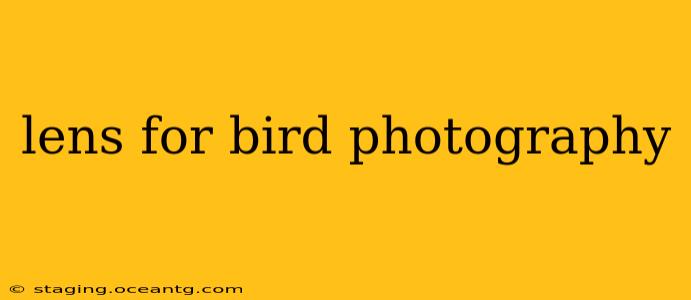Bird photography is a challenging but rewarding pursuit. Capturing crisp, detailed images of these agile creatures requires the right equipment, and the lens is arguably the most crucial component. This guide explores the best lenses for bird photography, catering to different budgets and skill levels, and answering frequently asked questions to help you choose the perfect optic for your needs.
What are the best lenses for bird photography?
The "best" lens depends heavily on your camera system, budget, and the type of bird photography you intend to do. However, generally speaking, telephoto lenses with long focal lengths are essential. These allow you to get close to your subject without disturbing it, capturing fine details like feather textures and eye expressions. Here's a breakdown of common choices:
-
Super-telephoto prime lenses: These lenses offer exceptional image quality and reach, typically ranging from 400mm to 600mm or even longer. They are ideal for capturing distant birds with stunning detail, but they are significantly more expensive and heavier than zoom lenses. Examples include the Canon EF 600mm f/4L IS III USM and the Nikon NIKKOR Z 600mm f/4 TC VR S.
-
Super-telephoto zoom lenses: These lenses provide versatility, offering a range of focal lengths (e.g., 100-400mm, 150-600mm) in a single lens. While not as sharp as prime lenses at their maximum reach, they offer convenience and adaptability, making them a popular choice for beginners and those who prefer lighter equipment. Examples include the Canon RF 100-500mm f/4.5-7.1 L IS USM and the Tamron 150-600mm f/5-6.3 Di VC USD G2.
-
Teleconverters: These are multipliers that attach to your existing telephoto lens, effectively increasing its focal length (e.g., a 1.4x teleconverter increases a 500mm lens to 700mm). While they are affordable, using teleconverters will reduce image quality and increase the risk of blurry images.
What focal length is best for bird photography?
The ideal focal length depends on the size of the bird and the distance you'll be shooting from. For smaller birds or shots where you need to fill the frame, a longer focal length (500mm and above) is preferable. For larger birds or when you have more space, a shorter focal length (300-400mm) might suffice. Many photographers find that a range between 400mm and 600mm offers a great balance of reach and practicality.
What aperture is best for bird photography?
A fast aperture (low f-number, like f/2.8 or f/4) is highly beneficial in bird photography. A fast aperture allows for faster shutter speeds, crucial for freezing motion and capturing sharp images, especially in low-light conditions. It also helps achieve shallow depth of field, blurring the background and making the bird stand out.
What is image stabilization (IS) or Vibration Reduction (VR)?
Image stabilization (IS) or Vibration Reduction (VR) is a technology built into many telephoto lenses that compensates for camera shake, helping to produce sharper images, particularly at slower shutter speeds or longer focal lengths. This is incredibly useful in bird photography, where slight movements can lead to blurry pictures. It’s highly recommended to invest in a lens with this feature.
Do I need a tripod for bird photography?
While not strictly necessary, a tripod is highly recommended for bird photography, especially when using long, heavy lenses. A tripod provides stability, preventing camera shake and ensuring sharp images, especially at longer shutter speeds. It becomes even more crucial when using teleconverters or in low light.
How much should I spend on a bird photography lens?
The cost of lenses for bird photography can vary significantly, ranging from a few hundred dollars for more basic zoom lenses to several thousand dollars for high-end prime lenses. Your budget will largely dictate your choice, but remember that investing in a quality lens will make a huge difference in the quality of your images. Consider your skill level and long-term goals before making a purchase. Starting with a good quality zoom lens can be a practical approach before committing to expensive prime lenses.
What are the best affordable lenses for bird photography?
Several excellent affordable options are available. Look into the Tamron 150-600mm lenses, or explore the various 100-400mm zoom lenses from different manufacturers. While they may not match the performance of top-tier primes at the extreme telephoto end, they are a great starting point and offer a good balance of versatility, image quality, and price.
This comprehensive guide offers a starting point for choosing the perfect lens for your bird photography adventures. Remember to consider your individual needs and budget when making your decision. Happy shooting!
